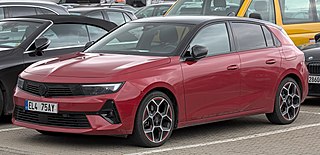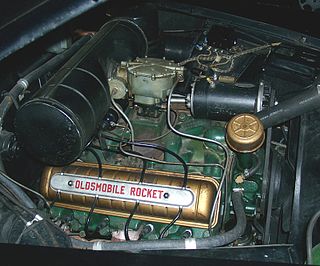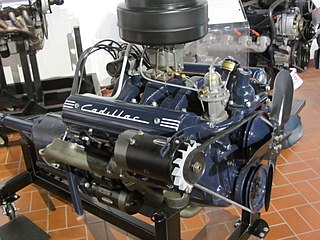
Oldsmobile was a brand of American automobiles, produced for most of its existence by General Motors. Originally established as "Olds Motor Vehicle Company" by Ransom E. Olds in 1897, it produced over 35 million vehicles, including at least 14 million built at its Lansing, Michigan factory alone.

The Opel Astra is a compact car/small family car (C-segment) developed and produced by the German automaker Opel since 1991, currently at its sixth generation. It was first launched in September 1991 as a direct replacement to the Opel Kadett. As of 2022, the car slots between the smaller Corsa supermini and the larger Insignia large family car.

The Opel Ascona is a large family car that was produced by the German automaker Opel from 1970 to 1988. It was produced in three separate generations, beginning with rear-wheel-drive and ending up as a front-wheel drive J-car derivative.

The Chevrolet small-block engine is a series of gasoline-powered V8 automobile engines, produced by the Chevrolet division of General Motors between 1954 and 2003, using the same basic engine block. Referred to as a "small-block" for its size relative to the physically much larger Chevrolet big-block engines, the small block family spanned from 262 cu in (4.3 L) to 400 cu in (6.6 L) in displacement. Engineer Ed Cole is credited with leading the design for this engine. The engine block and cylinder heads were cast at Saginaw Metal Casting Operations in Saginaw, Michigan.

The General Motors 60° V6 engine family is a series of 60° V6 engines produced for both longitudinal and transverse applications. All of these engines are 12-valve cam-in-block or overhead valve engines, except for the LQ1 which uses 24 valves driven by dual overhead cams. These engines vary in displacement between 2.5 and 3.4 litres and have a cast-iron block and either cast-iron or aluminum heads. Production of these engines began in 1980 and ended in 2005 in the U.S., with production continued in China until 2010. This engine family was the basis for the GM High Value engine family. These engines have also been referred to as the X engines as they were first used in the X-body cars.

The Buick V6 was an OHV V6 engine developed by the Buick division of General Motors and introduced in 1962. Originally 198 cu in (3.2 L) and initially marketed as Fireball, it later became popularly referred to as the 3800 for its various 3.8 L (230 cu in) incarnations.

The Oldsmobile V8, also referred to as the Rocket, is series of engines that was produced by Oldsmobile from 1949 until 1990. The Rocket, along with the 1949 Cadillac V8, were the first post-war OHV crossflow cylinder head V8 engines produced by General Motors. Like all other GM divisions, Olds continued building its own V8 engine family for decades, adopting the corporate Chevrolet 350 small-block and Cadillac Northstar engine only in the 1990s. All Oldsmobile V8s were manufactured at plants in Lansing, Michigan while the engine block and cylinder heads were cast at Saginaw Metal Casting Operations.

The term Cadillac V8 may refer to any of a number of V8 engines produced by the Cadillac Division of General Motors since it pioneered the first such mass-produced engine in 1914.

The 122 engine was designed by Chevrolet and was used in a wide array of General Motors vehicles. The 122 was similar to the first two generations of the General Motors 60° V6 engine; sharing cylinder bore diameters and some parts. The 122 was available in the US beginning in 1982 for the GM J platform compact cars and S-series trucks.

The GM Family I is a straight-four piston engine that was developed by Opel, a former subsidiary of General Motors and now a subsidiary of PSA Group, to replace the Vauxhall OHV, Opel OHV and the smaller capacity Opel CIH engines for use on small to mid-range cars from Opel/Vauxhall. The engine first appeared in the Opel Kadett D in 1979, and shortly afterwards in its Vauxhall badged sister - the Vauxhall Astra Mk.1 in 1980. Despite this, the previous Opel OHV engine continued to be sold in entry level versions of the Opel Kadett/Astra and Corsa throughout the 1980s.
Multijet is Stellantis's term for its current common rail direct injection turbodiesel engine range. Most of the Fiat, Alfa Romeo, and Lancia range, as well as certain Chrysler, RAM Trucks, Jeep, and Maserati vehicles, are equipped with Multijet engines. Ownership of some Fiat Multijet designs is shared with General Motors as part of a settlement of the failed merger between the two auto conglomerates. The GM Powertrain Torino group in Turin, Italy, manages its interest in these engines. Some PSA Peugeot Citroën diesel engines are also rebadged JTD units, and vice versa. Fiat's common-rail diesel engine is also known as JTD, an initialism of Jet Turbo Diesel.

The Chevrolet Opala is a Brazilian mid-size car sold under the Chevrolet brand in South America from 1969 to 1992, by General Motors do Brasil. It was derived from the German Opel Rekord Series C, Opel Commodore Series A, but used local design styling and engines derived from North American designs. GM manufactured about one million units including the Opala sedan, Opala Coupé, and the station wagon variant, the Opala Caravan. It was replaced by the Chevrolet Omega in 1992, also an Opel spinoff. It was the first passenger car built by GM in Brazil by the General Motors do Brasil division. A luxury version of the Opala was marketed as the Chevrolet Diplomata.
Delco Electronics Corporation was the automotive electronics design and manufacturing subsidiary of General Motors based in Kokomo, Indiana, that manufactured Delco Automobile radios and other electric products found in GM cars. In 1972, General Motors merged it with the AC Electronics division and it continued to operate as part of the Delco Electronics division of General Motors. When the corporation acquired the Hughes Aircraft Company, Delco was merged with it to form Hughes Electronics as an independent subsidiary.
The Quadrajet is a four barrel carburetor, made by the Rochester Products Division of General Motors. Its first application was the new-for-1965 Chevy 396ci engine. Its last application was on the 1990 Oldsmobile 307 V8 engine, which was last used in the Cadillac Brougham and full size station wagons made by Chevrolet, Pontiac, Oldsmobile, and Buick.

The history of General Motors (GM), one of the world's largest car and truck manufacturers, dates back more than a century and involves a vast scope of industrial activity around the world, mostly focused on motorized transportation and the engineering and manufacturing that make it possible. Founded in 1908 as a holding company in Flint, Michigan, as of 2012 it employed approximately 209,000 people around the world. With global headquarters at the Renaissance Center in Detroit, Michigan, United States, General Motors manufactures cars and trucks in 35 countries. In 2008, 8.35 million GM cars and trucks were sold globally under various brands. Current auto brands are Buick, Cadillac, Chevrolet, GMC, Baojun, and Wuling. Former GM automotive brands include LaSalle, McLaughlin, Oakland, Oldsmobile, Opel, Pontiac, Hummer, Saab, Saturn, Vauxhall, Daewoo, and Holden.

Holley Performance Products is an automotive performance company based in Bowling Green, Kentucky. It was founded in 1896 in Bradford, Pennsylvania, by George Holley and Earl Holley. When the company was based in Michigan it was a major producer of carburetors for many Detroit-built automobiles.
ACDelco is an American automotive parts brand owned by General Motors (GM). Factory parts for vehicles manufactured by GM are consolidated under the ACDelco brand, which also offers aftermarket parts for non-GM vehicles. Over its long history it has been known by various names such as United Motors Corporation, United Motors Service, and United Delco. The brand "ACDelco" should not be confused with GM's former AC Delco Systems, formed in 1994 from the merger of AC Rochester Division and Delco Remy Division. In 1995 Delphi Automotive Systems absorbed AC Delco Systems.

The Opel Kadett C is a small family car which was produced by the German automobile manufacturer Opel from 1973 to 1979. The Kadett C, which was the fourth generation of the Opel Kadett, was released in August 1973, and was Opel's version of the General Motors "T-Car". It was the last small Opel to feature rear-wheel drive, and remained in production at Opel's Bochum plant until July 1979, by which time Opel had produced 1,701,076. Of these, 52% had been exported outside West Germany, most of them to markets in other parts of western Europe. In other world markets, however, various badge engineered versions of the Kadett C remained in production as late as the mid-1990s under other GM brand names.

The Chevrolet Turbo-Thrift engine is a straight-six produced from 1962 to 2001 by the Chevrolet division of General Motors. The entire series of engines was commonly called Turbo-Thrift, although the name was first used on the 230 cubic inch version that debuted in 1963. The new engine featured seven main bearings in lieu of the four bearing design of its predecessor, the "Stovebolt" engine, and was considerably smaller and approximately 100 lbs lighter.

















